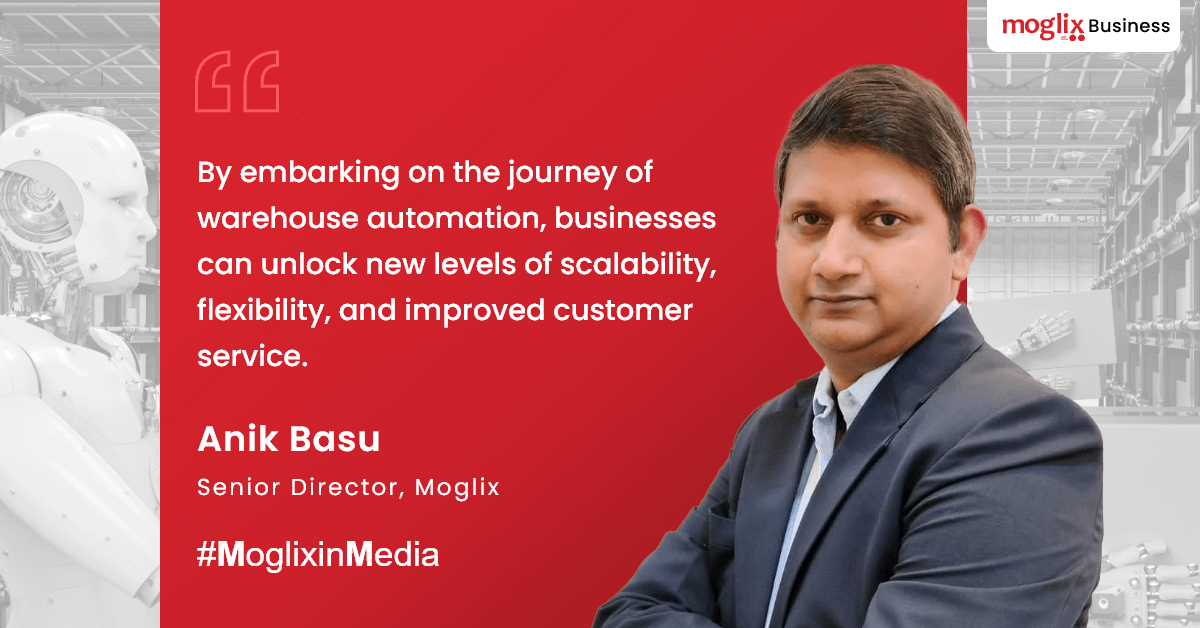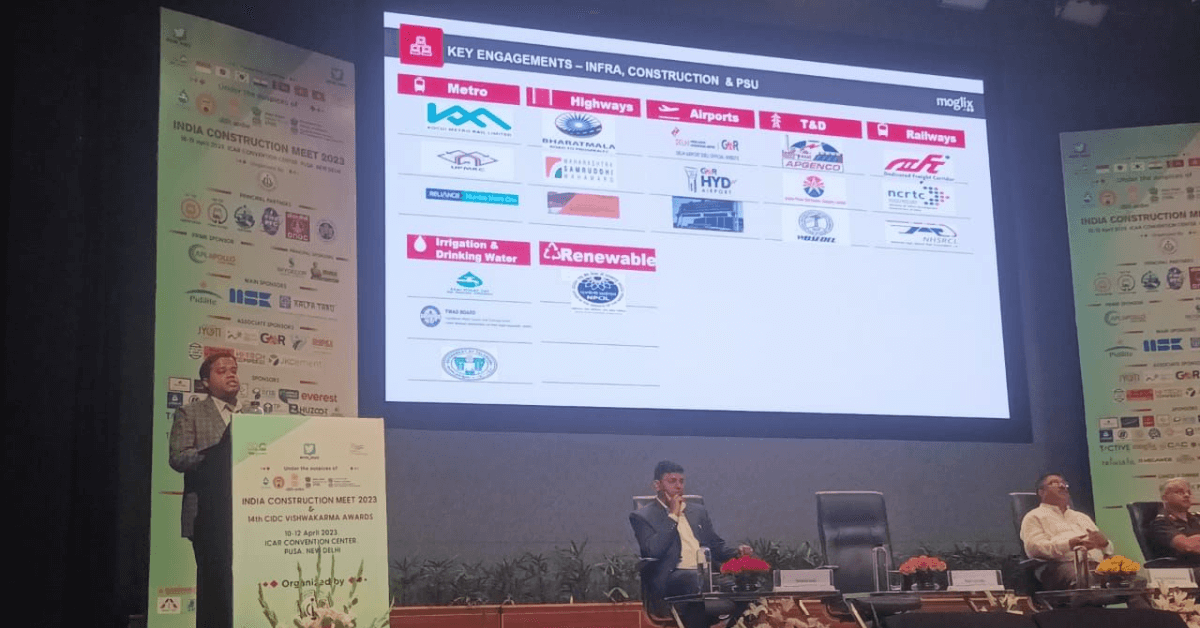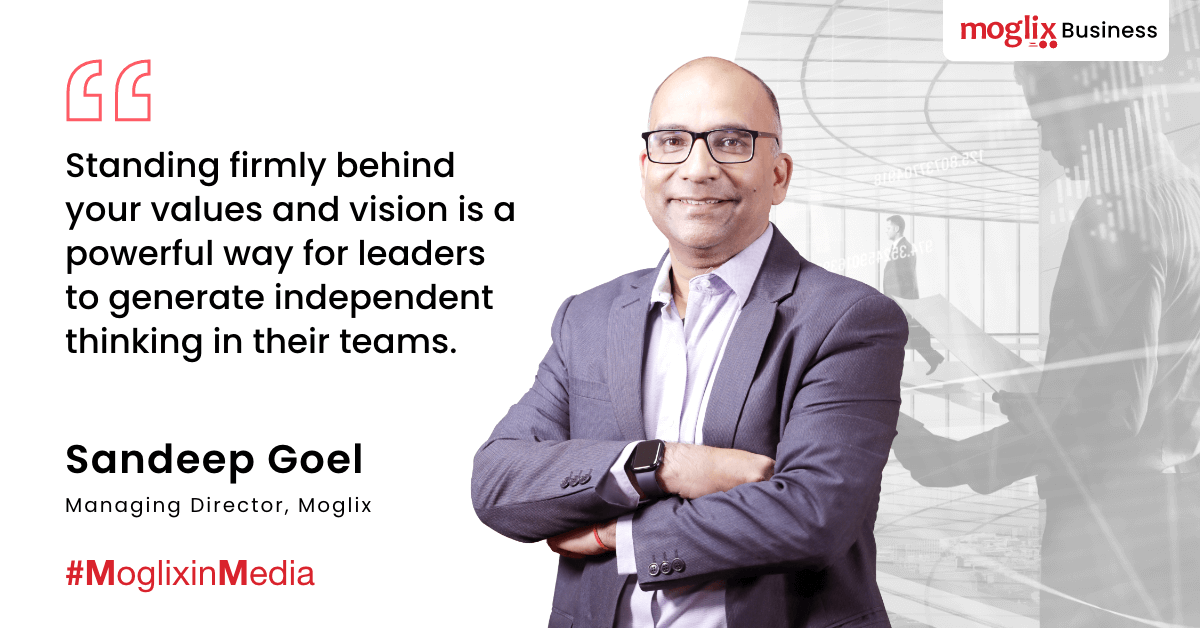ET RetailTech Summit 2023

ET RetailTech Summit 2023
Credlix podcast with Quantico

Credlix podcast with Quantico
Date: May 19, 2023
Organizer: Credlix in collaboration with Quantico
About the Event: Uncover the keys to success and unlock boundless growth opportunities for your business!
Join us for an exclusive podcast where Pramit Joshi, Senior Director at Credlix, engages in a dynamic conversation with Shubhada Rao, Founder of QuantEco, and Vivek Kumar, Economist at QuantEco. Gain invaluable strategies and actionable tips for managing exports and thriving in the current climate.
CIPS MENA Conference and Excellence in Procurement Awards

CIPS MENA Conference and Excellence in Procurement Awards
Date: May 10, 2023
Organizer: Chartered Institute of Procurement and Supply (CIPS)
About the Event: Partha S Dash (Managing Director, Moglix) moderated an insightful session on the topic – “Collaboration or Competition: What’s more advantageous for business?” at the CIPS MENA Conference & Excellence in Procurement Awards in UAE.
PPE Chronicles: Ensuring Chemical Industry Safety Through PPE Effective Programs

PPE Chronicles: Ensuring Chemical Industry Safety Through PPE Effective Programs
Worker safety is paramount in any industry, especially in the chemical industry. Personal Protective Equipment (PPE) plays a vital role in safeguarding workers from potential hazards and minimizing the risks associated with chemical exposures. However, it is crucial to evaluate the effectiveness of PPE programs to ensure optimal protection.
The Role of PPE in the Chemical Industry:
Chemical manufacturing and handling processes pose various hazards, including chemical spills, fumes, and corrosive substances. PPE acts as a critical line of defense, reducing the likelihood of injuries and long-term health effects. According to the Occupational Safety and Health Administration (OSHA), wearing appropriate PPE can reduce the risk of chemical-related injuries by 90%.
Understanding the Evaluation Process
Evaluating PPE programs involves analyzing several key elements. Incident analysis allows us to assess the effectiveness of PPE in mitigating or preventing accidents. Compliance tracking helps ensure that workers consistently adhere to PPE protocols, minimizing the chances of exposure. Gathering feedback from workers about their experiences with PPE provides valuable insights for improvement.
Assessing PPE Compliance and User Feedback:
Tracking and monitoring PPE compliance is crucial for evaluating program effectiveness. As per study companies with high compliance rates had significantly lower injury rates compared to those with poor compliance. Additionally, gathering feedback from workers through surveys and interviews helps identify areas for improvement, such as comfort, fit, and ease of use.
Analyzing Incidents and Accidents:
Examining past incidents and accidents helps us understand the role of PPE in preventing or mitigating injuries. Statistical data from the Chemical Safety Board showed that in 75% of chemical accidents resulting in severe injuries, the workers involved either did not wear PPE or wore inadequate protection. This highlights the critical importance of proper PPE usage in preventing accidents and reducing their severity.
Key Performance Indicators (KPIs) for Evaluation:
To measure the effectiveness of PPE programs, specific KPIs can be used. Incident rates, such as the number of chemical-related injuries or near misses, serve as valuable indicators. Conducting regular worker satisfaction surveys can provide insights into the perceived effectiveness and usability of PPE. These metrics help gauge the success of PPE programs and identify areas that require attention.
Continuous Improvement Strategies:
Continuous improvement is essential for enhancing PPE programs. Incorporating worker feedback, conducting regular training sessions, and staying updated on industry best practices are effective strategies. Initiatives like an annual PPE training program can significantly reduce PPE related incidents, demonstrating the value of ongoing improvement efforts.
Cost-Benefit Analysis:
Investing in PPE programs incurs costs, but the benefits outweigh them. According to the National Safety Council, the average cost of a chemical-related injury in the workplace is $40,000. Comparatively, the cost of providing appropriate PPE and implementing an effective program is significantly lower. By preventing accidents and reducing injuries, PPE programs result in long-term cost savings for companies.
Evaluating the effectiveness of PPE programs is vital to ensure the safety of workers in the chemical industry. Through incident analysis, compliance tracking, user feedback, and continuous improvement strategies, companies can optimize their PPE programs. By investing in worker safety and utilizing effective PPE, organizations can create safer working environments and prevent potentially devastating accidents. Also, it is an ongoing process, and staying proactive is key to protecting workers and minimizing risks in the chemical industry. At Moglix, you have access to the most comprehensive range of safety supplies and solutions. You can find a range of PPE solutions specifically designed for chemical industry. Contact us today and partner with us to build a safer environment.
Innovation in Motion: Exploring the Journey of Warehouse Automation

Innovation in Motion: Exploring the Journey of Warehouse Automation
In today’s hyper-competitive business environment, staying ahead of the curve is a prerequisite for survival. With the market for warehouse automation projected to reach $37.6 billion by 2030, businesses cannot afford to ignore the transformative potential of automation. While more than 80% of warehouses lack any form of automation, the market is rapidly evolving, with an estimated CAGR of 10% between 2021 and 2030.
The benefits of automation are undeniable: increased efficiency, improved accuracy, enhanced safety, scalability, flexibility, improved customer service, and a significant competitive advantage.
Leveraging Technology for Streamlined Compliance Tracking in PPE Programs

Leveraging Technology for Streamlined Compliance Tracking in PPE Programs
Personal protective equipment (PPE) is essential for protecting workers from hazards in the workplace. However, ensuring that PPE is used correctly and consistently can be a challenge. This is where compliance tracking comes in. Compliance tracking is the process of monitoring and documenting the use of PPE to ensure that it is being used correctly and consistently.
There are a number of ways to implement a compliance tracking system. One option is to use a paper-based system. This involves creating and maintaining paper records of PPE use. However, paper-based systems can be time-consuming and inefficient. They can also be difficult to maintain and keep up-to-date. When it comes to compliance tracking in PPE programs, leveraging technology can be a game-changer. By adopting the right tools and software, organizations can streamline their compliance efforts, improve accuracy, save time, and ensure a safer work environment.
Technology-based systems can automate many of the tasks involved in compliance tracking, such as data entry and reporting. This can save time and resources, and can help to ensure that compliance tracking is more accurate and efficient. There are a number of different technology-based compliance tracking systems available. When choosing a system, it is important to consider the specific needs of your organization. Some factors to consider include:
- The size of your organization
- The types of hazards your workers face
- The number of employees who need to use PPE
- Your budget
Why Automate?
Let’s understand various ways technology can be utilized to achieve streamlined compliance tracking in PPE programs.
Automated Data Collection and Reporting:
Technology allows for the automation of data collection processes, eliminating the need for manual recordkeeping. Organizations can use barcode scanning, RFID tags, or mobile apps to track PPE usage, inspections, and maintenance. This automated data collection enables real-time tracking and generates comprehensive reports that provide insights into compliance status, usage patterns, and potential areas for improvement.
Inventory Management Systems:
Managing PPE inventory can be a daunting task, especially for organizations with large-scale operations. Implementing an inventory management system can simplify this process. These systems use technology to track PPE stock levels, monitor expiration dates, and generate alerts for restocking. By ensuring an adequate supply of PPE at all times, organizations can maintain compliance and minimize the risk of employees working without proper protection.
Training and Certification Platforms:
Technology offers innovative solutions for delivering and tracking employee training and certifications related to PPE. Online training platforms enable employees to access relevant training modules at their convenience, ensuring consistent and standardized training across the organization. These platforms can also track and document employees’ progress, allowing employers to verify compliance with training requirements. At Moglix, we partner with organizations to provide safety solutions that go beyond just procurement of safety supplies. Our understanding of the entire value chain, allows us to focus on factors like Safety audits & End user training, that are often ignored, but important to create a safety culture within any organization.
Mobile Apps for Inspections and Audits:
Mobile applications are powerful tools for conducting inspections and audits related to PPE compliance. Inspectors can use mobile apps to complete checklists, capture photos of equipment and hazards, and record observations in real-time. This approach facilitates efficient data collection, reduces paperwork, and enables immediate corrective actions to address any non-compliance issues identified during inspections.
Integration with Environmental Health and Safety (EHS) Systems:
Integrating compliance tracking technology with existing Environmental Health and Safety (EHS) systems can further streamline PPE programs. By centralizing data and workflows, organizations can achieve a holistic view of safety compliance, including PPE requirements. This integration enables efficient data sharing, analysis, and reporting, leading to better decision-making and continuous improvement of PPE programs.
Incorporating technology into compliance tracking for PPE programs brings numerous benefits to organizations. It enhances data accuracy, saves time, improves efficiency, and ultimately contributes to a safer work environment. By leveraging automated data collection, inventory management systems, training platforms, mobile apps, and integration with EHS systems, organizations can streamline their compliance efforts, reduce risks, and ensure that employees are adequately protected through the proper use of personal protective equipment.
For Moglix safety is more than just safety products. It’s about working together, to analyze and understand all safety options and requirements needed to send your employees home safely. We assess your data and facility, to engineer out hazards, helping you define clear SOPs. We then train your employees through simulated VR training modules to enable easy understanding and acceptance.
Our engagement with you doesn’t stop at just training. Moglix works with safety consultants and safety auditors to help you design proactive and periodic audit plans. Be it electrical, fire, OSHA or wash audit, we have certified professionals who can help you with any type of audit. Safety Simplified
Podcast with Shripati Acharya, Managing Partner at Prime Venture Partners

Podcast with Shripati Acharya, Managing Partner at Prime Venture Partners
Date: April 29, 2023
Organizer: Prime Venture Partners
About the Event: Mr. Rahul Garg (Founder and CEO, Moglix) recently recounted his entrepreneurial journey and highlighted the evolution of B2B commerce in India during a podcast with Shripati Acharya (Managing Partner at Prime Venture Partners).
Mining Investment Conferences and Exhibitions

Mining Investment Conferences and Exhibitions
Date: April 19- 20th, 2023
Organizer: Spire Events
About the Event:Mr. Rahul Garg (Founder & CEO, Moglix) recently presented at the 4th Annual Mining Investment Conferences & Exhibitions London on ‘Transforming Procurement & Supply Chain for Metals and Mining Sector’ in London, United Kingdom where he talked about the key priorities for Metals and Mining Industry and how the e-commerce model can be a game changer for the industry.
India Construction meet

India Construction meet
Date: April 10-12th, 2023
Organizer: Construction Industry Development Council
About the Event:Mr. Saikat Roy (Director, Infra & PSU, Moglix Business) recently addressed the community of EPC companies and OEMs that are building India’s infrastructure, at the India Construction Meet 2023 and 14th Construction Industry Development Council Vishwakarma Awards in New Delhi.
Unleashing the Power of Independent Thinking: A Leader`s Guide

Unleashing the Power of Independent Thinking: A Leader`s Guide
Unleashing the Power of Independent Thinking: A Leader’s GuideRead More
